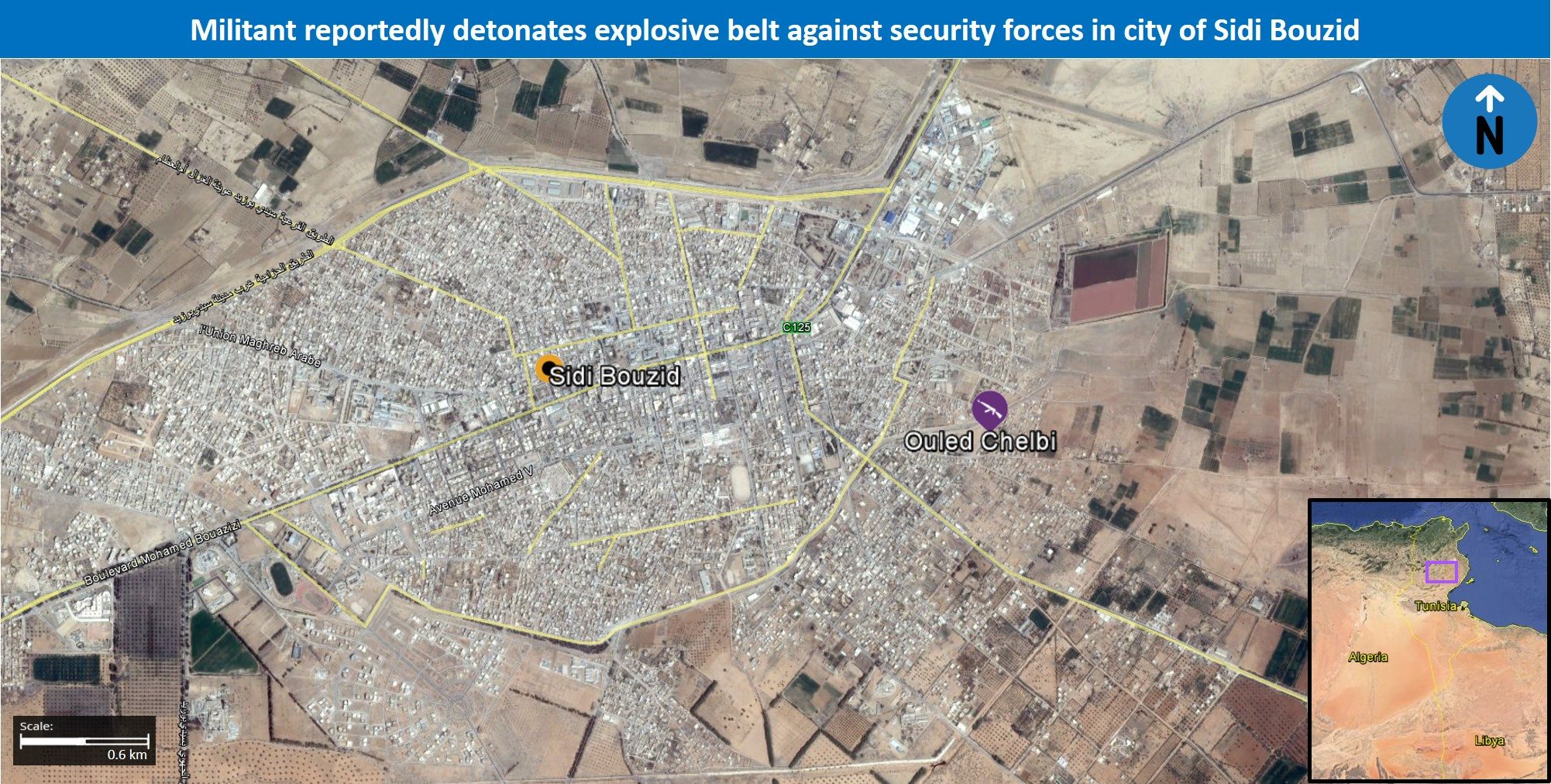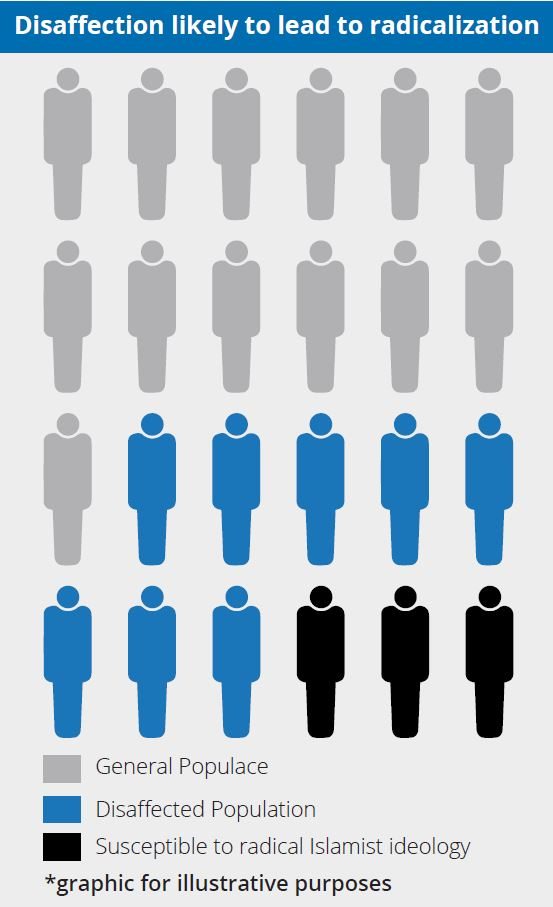Current Situation: Suicide Bombing in Sidi Bouzid
According to the state news agency, clashes between militants and security personnel in Sidi Bouzid which commenced during the morning hours of April 30, had concluded in the late afternoon hours. According to the source, in addition to a militant who previously died when detonating an explosive belt and another who was fatally shot by security forces, four other militants were arrested, while no casualties were inflicted on security personnel. Initial reports suggest that one of the militants who was killed was “an emir of Okba Ibn Nafaa Brigade (OIB)”, referring to the local affiliate of al-Qaeda in the Islamic Maghreb (AQIM), and that the cell had “capitalized on civil unrest to infiltrate the area, and had planned to conduct an attack during the month of Ramadan”.
Assessments & Forecast
While complete details surrounding the incident have yet to fully emerge at the time of writing, the incident is highly notable due to the reported use of a suicide belt, which indicates a relatively high-level of sophistication and the capabilities of the militants, as well as a likely desire to conduct a high-profile attack. That being said, as no casualties were caused to security forces, as well as the fact that the incident itself took place in a remote location and appeared to not have been aimed at a notable target as would be expected in such an attack, indicate that the incident was not the attack meant to be carried out by the militants. Instead, it is more likely that security forces detected the militants when the latter were still ahead of launching their intended attack, and targeted them, thus forcing them to react, foiling the originally planned militant operation. These developments, in turn, underscore the relatively high capabilities of Tunisian security forces, as they were able to detect and confront the militants, likely foiling what would have been a large-scale attack.
Furthermore, given that there were several militants involved in the incident, it is possible that their plan involved conducting a multi-pronged attack involving a suicide bomber as well as small arms fire, thus maximizing the potential level of casualties. Furthermore, despite the location in which the incident took place, it cannot be ruled out that the militants were using the area for staging purposes prior to locating to a different part of the country where the actual attack would have been conducted, which could have included a central city in the country or a soft target, such as a tourist locale or strategic infrastructure.
Moreover, the incident serves to underscore the persistent underlying threat of militant attacks in Tunisia, presented by the Islamic State (IS) and AQIM through its local affiliate OIB, who both have a known physical presence in the country. This threat is further manifested in frequent arrests of militants of various capacities throughout the country, as well as less frequent attacks conducted in the outlying areas of the country, which are mostly aimed at security forces and related targets.
With this in mind, such a persistent entrenchment of militants in Tunisia, despite efforts to the contrary which include a nationwide ongoing state of emergency, are the result of three main factors in particular. First, the populaces’ growing susceptance to radicalization, particularly in the outlying areas of Tunisia, which is a result of prolonged economic difficulties and growing disenchantment with the events following the 2011 revolution due to a perception of marginalization by the government. This allows for a large pool of potential recruits for militant groups, but also logistic support to active cells, which facilitate their operations within the population’s midst. Second, the terrain in which militant groups operate, which largely includes mountains and dense vegetation, making it harder to detect militants and providing them with an advantage when attempting to avoid or confront security forces. Third, the porous borders with Libya and Algeria, in which both AQIM and IS have a presence, which allows militants to transfer fighters and weapons into Tunisia to support their efforts in the country.
Taken as a whole, the development is indicative of the intentions of militants to conduct a high profile attack in Tunisia, likely as part of their interest to expand their operations in the country and assume a more prominent role in it. This coincides with a similar process witnessed in Algeria, and likely stems from the ongoing regional competition between IS and AQIM over dominance of the Jihadist landscape, which will grant either of the group’s leverage when vying for their shared resource pool, namely potential recruits, funds, and popular support from the global radicalized Islamist population. FORECAST: With this in mind, given the persistent threat of militancy in the country, coupled with the reported arrest of several of the militants who may provide valuable intelligence information, the Tunisian security forces are liable to launch additional arrest raids throughout the country over the coming days and weeks in order to further mitigate this persistent risk. Nonetheless, given the proven high motivation and capabilities of militants, the manifestation of a successful high profile attack occurring again in Tunisia over the coming weeks and months cannot be ruled out.
Recommendations
Travel to Tunis may continue while adhering to all security precautions regarding militancy and civil unrest. Those operating or residing in Tunisia are advised that we maintain operational capabilities in the country. Contact us at [email protected] or +44 20-3540-0434 for itinerary and contingency support options. We currently advise to maintain heightened vigilance in Tunisia’s coastal areas while avoiding nonessential travel to other outlying towns and cities due to the lack of travel and tourist infrastructure and a heightened risk for civil unrest and militancy. In addition, avoid nonessential travel to the vicinity of government and security installations, as well as political meetings, while maintaining heightened vigilance in the vicinity of hotels and touristic sites, due to the potential threat of militant attacks against such locales. Avoid all travel to the Kasserine, Kef, and Jendouba Governorates, in addition to all border areas, due to jihadist activity and military closures. Furthermore, avoid all travel to within 50 km from the border with Libya, due to the increased threat of attacks originating from Libya targeting Tunisian interests.

